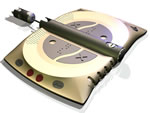Digital Technology to Bring Books to Life
Since the 1970s, analog cassettes have enabled the Library of Congress, National Library Service for the Blind and Physically Handicapped (NLS) to deliver reliable and entertaining audio books and magazines to people who are unable to read standard print. Analog technology continues to work, but now it's time for something new. NLS has found the answer in technology unavailable thirty years ago.
"Digital talking books will bring a great range of benefits to blind and physically handicapped readers," says Frank Kurt Cylke, NLS director. "Many of the marvelous capabilities of the printed book will be combined with the power of computers to create a tool of unprecedented flexibility and power."
NLS will use digital technology to enhance the listening experience. What makes digital better than analog? Users can easily navigate through a book. Sound quality will improve. Less handling will be required. And that's only the beginning.
Fast forward to the future. Each patron will have access to a flash-based playback machine and will be able to download digital books and magazines from the Internet.
Digital Transformation
After 10 years of research, NLS chose flash memory as the framework for its new system. How will it work? Imagine a lightweight playback device with a removable cartridge that allows for faster access to the content of a book. In 2008, this dream becomes reality.
A digital talking book (DTB) will resemble a credit card, only slightly larger. It will be a high-density flash memory cartridge, capable of holding a complete book. Each book's digital master will be compressed to fit the cartridge at a rate that will deliver high quality audio. The books will be labeled in both large print and braille.
In the race to project completion, NLS is off and running. In 2002, NLS began the digital audio book production and conversion process. By 2008, the program will provide players and have a collection of 20,000 digital titles.
"The greatest challenge of the digital transition is pulling several long-term and complex projects together to function smoothly," says Jean M. Moss, NLS digital projects coordinator. "It is critical to the successful implementation of the digital program that all key stakeholders -- patrons, network libraries and their administering agencies, producers, and staff-be involved, to some extent, in the design and implementation process." NLS will continue to collaborate with stakeholders through user studies and meetings with the digital long-term planning committee. Book titles expected to be among the most popular 20 percent, which constitute 80 percent of total circulation, are slated to be mass-produced and distributed by network libraries. The remaining titles, constituting 20 percent of total circulation, will be duplicated on demand through a distribution center that will service patrons nationwide.
Driving the digital effort is the goal to make the reading experiences for patrons more enjoyable. "The most exciting feature of digital talking books is the reader's ability to easily navigate through the book. All books will include a basic level of navigation that allows the reader to jump to various chapters and sections," says Moss. "The navigation capabilities will vary with the type of book, for example, fiction and non-fiction."
The design of the flash-based machines will be cost efficient. The talking book and solid state playback machine will have no moving parts which will keep repair costs low. NLS plans to build 60,000 digital playback machines by 2008. "The production quantity of DTB players will be increased in subsequent years to satisfy patron demand," says Moss.
Flash Benefits
Why should blind and physically handicapped readers get excited about the new technology? Here are a few good reasons: better sound quality in playback; fewer items to keep track of (generally one cartridge instead of several cassettes as is required with the cassette system), and no need to flip a switch or the cartridge during playback.
Libraries also have compelling reasons to embrace the digital transformation. Flash memory will require less storage space for collections; memory cards can be reused many times without loss of quality; playback devices will be compact, lightweight and durable, and require fewer repairs; and the playback devices are expected to be less expensive.
"We've received positive comments on the move to a digital system from network librarians and patrons," says Michael Moodie, NLS deputy director. "The end result of the conversion process will exceed expectations."
Meet Dook
Meet "Dook," first place winner of the 2002 Digital Audio Playback Device Competition
for students,  sponsored by the Industrial Designers Society of America and NLS. Created by
Lachezar Tsvetanov, a University of Bridgeport senior and a native Bulgarian, Dook was
named for its resemblance to a print book. Its hinged spine folds flat for carrying and
provides easy access to controls. While the contest was designed to spur ideas for the
digital talking book machine, the final design has not been selected.
sponsored by the Industrial Designers Society of America and NLS. Created by
Lachezar Tsvetanov, a University of Bridgeport senior and a native Bulgarian, Dook was
named for its resemblance to a print book. Its hinged spine folds flat for carrying and
provides easy access to controls. While the contest was designed to spur ideas for the
digital talking book machine, the final design has not been selected.
